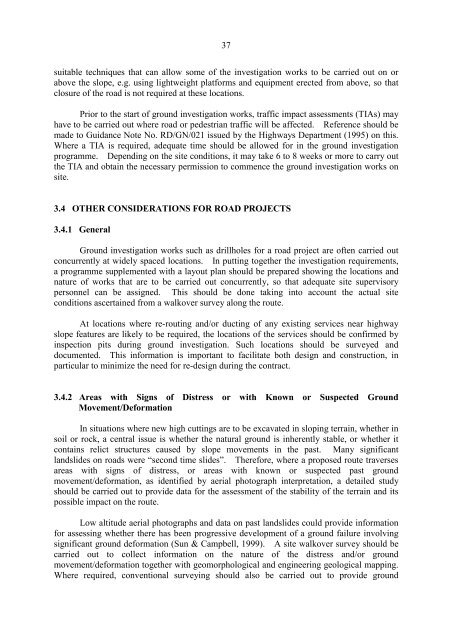Highway Slope Manual
Highway Slope Manual
Highway Slope Manual
Create successful ePaper yourself
Turn your PDF publications into a flip-book with our unique Google optimized e-Paper software.
37<br />
suitable techniques that can allow some of the investigation works to be carried out on or<br />
above the slope, e.g. using lightweight platforms and equipment erected from above, so that<br />
closure of the road is not required at these locations.<br />
Prior to the start of ground investigation works, traffic impact assessments (TIAs) may<br />
have to be carried out where road or pedestrian traffic will be affected. Reference should be<br />
made to Guidance Note No. RD/GN/021 issued by the <strong>Highway</strong>s Department (1995) on this.<br />
Where a TIA is required, adequate time should be allowed for in the ground investigation<br />
programme. Depending on the site conditions, it may take 6 to 8 weeks or more to carry out<br />
the TIA and obtain the necessary permission to commence the ground investigation works on<br />
site.<br />
3.. OTHER CONSIDERATIONS FOR ROAD PROJECTS<br />
3...1 General<br />
Ground investigation works such as drillholes for a road project are often carried out<br />
concurrently at widely spaced locations. In putting together the investigation requirements,<br />
a programme supplemented with a layout plan should be prepared showing the locations and<br />
nature of works that are to be carried out concurrently, so that adequate site supervisory<br />
personnel can be assigned. This should be done taking into account the actual site<br />
conditions ascertained from a walkover survey along the route.<br />
At locations where re-routing and/or ducting of any existing services near highway<br />
slope features are likely to be required, the locations of the services should be confirmed by<br />
inspection pits during ground investigation. Such locations should be surveyed and<br />
documented. This information is important to facilitate both design and construction, in<br />
particular to minimize the need for re-design during the contract.<br />
3...2 Areas with Signs of Distress or with Known or Suspected Ground<br />
Movement/Deformation<br />
In situations where new high cuttings are to be excavated in sloping terrain, whether in<br />
soil or rock, a central issue is whether the natural ground is inherently stable, or whether it<br />
contains relict structures caused by slope movements in the past. Many significant<br />
landslides on roads were “second time slides". Therefore, where a proposed route traverses<br />
areas with signs of distress, or areas with known or suspected past ground<br />
movement/deformation, as identified by aerial photograph interpretation, a detailed study<br />
should be carried out to provide data for the assessment of the stability of the terrain and its<br />
possible impact on the route.<br />
Low altitude aerial photographs and data on past landslides could provide information<br />
for assessing whether there has been progressive development of a ground failure involving<br />
significant ground deformation (Sun & Campbell, 1999). A site walkover survey should be<br />
carried out to collect information on the nature of the distress and/or ground<br />
movement/deformation together with geomorphological and engineering geological mapping.<br />
Where required, conventional surveying should also be carried out to provide ground

















